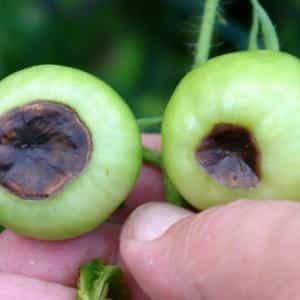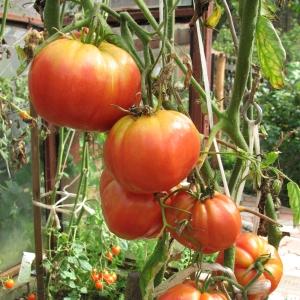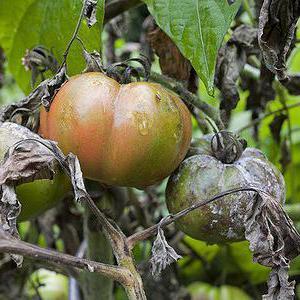How to deal with blossom end rot of tomatoes in a greenhouse: the best recipes and folk methods
Tomato diseases are a common occurrence for any gardener. In order to protect plants from soil drying out, frosts, and other adverse weather conditions, tomatoes are often grown in greenhouses. However, if the temperature regime or watering is violated, even in a greenhouse environment, tomatoes may encounter diseases and pests.
In this article we will talk about such a common tomato disease as blossom end rot. Let's figure out how to deal with it and what preventive measures to take to keep your crops healthy and produce more harvests.
What kind of disease is this
Blossom rot is not an infectious disease. It affects plants both in greenhouses and in open ground.
Most often, young bushes that are just beginning to bear fruit are susceptible to rot. The main unpleasant consequence is a severe reduction in yield. The disease is more of a physiological nature and is not associated with infections and pests, but can be caused by bacteria.
Carefully! Although blossom end rot does not kill the entire plant, infected fruits should not be eaten.
Symptoms and external signs
If you detect the onset of the disease in a timely manner, you can effectively fight it. Blossom rot affects fruits starting from the area where the flower attaches.In many varieties, this part is hidden from view, so in order to promptly determine the presence of infection, you need to periodically carefully inspect the bushes.
At the beginning of infection, an almost imperceptible watery spot appears at the top of the fruit. Over time, the skin around it acquires a brown tint and becomes dry. The surface appears as if dented.
Externally, the size of the damage may be small, but significant changes occur inside:
- Bacteria appear on the infected part of the skin and penetrate into the fruit;
- the tomato pulp darkens and rots;
- Seeds are also affected.
One of the distinctive external signs of blossom end rot is that the affected fruit begins to ripen earlier than the rest.
Reasons for appearance
Bacteria and fungi have always been considered the cause of various diseases in tomatoes.
However, unlike, for example, gray rot, the main cause of blossom end rot is calcium deficiency of the fruit tips. This means that the tomato receives few calcium salts, which are not enough for the proper growth and division of cells in the pulp and skin of the fruit.
The tops of the fruits are most affected by nutrient deficiencies. That is why blossom end rot affects all the fruits on the bunch at once. Hence the large loss of harvest.
Calcium deficiency occurs for several reasons:
- lack of moisture;
- increased salinity and acidity of the soil;
- damage to the root system;
- situations that are stressful for the crop (for example, watering with ice water in hot weather or sudden temperature changes).
How to deal with blossom end rot
How can you treat tomatoes to prevent disease? We can say with confidence that the use of special drugs will give a positive result:
- calcium chloride solution to feed the plant;
- special microbiological preparations, such as “Fitosporin”;
- substances containing copper, for example, Bordeaux mixture;
- treating seeds before planting with a solution of potassium permanganate or a solution of succinic acid;
- to increase overall disease resistance, it is recommended to treat seeds with any growth stimulant before planting;
- limestone nitrate for foliar feeding;
- spraying leaves with a solution of calcium chloride during the period of active growth;
- spraying with lime milk;
- application of fertilizers “Nutrivant PLUS” and “Fertivant”.
There are also folk remedies for preventing and getting rid of crown rot:
- planting tomatoes at a sufficient distance. Branches and leaves should not be intertwined;
- stepsoning;
- watering plants in the greenhouse every other day, and at high temperatures it is better to switch to daily abundant watering;
- frequent ventilation in greenhouses or greenhouses;
- adding eggshells and ashes to the holes.
Read also:
Disease-resistant and easy-to-care tomato “Gina”.
Spectacular appearance and unusual taste: Kumato tomatoes and the secrets of growing them.
Preventive measures
Of course, it is always easier to prevent a disease than to treat it. This also applies to tomato diseases.
Prevention of blossom end rot disease begins with proper preparation of the soil for planting, as well as compliance with certain rules of agricultural technology:

- The first and most important way to prevent the disease is timely, even watering of plants;
- Try to avoid sudden fluctuations in humidity;
- The top layer of soil should remain loose, so the next day after watering the soil should be loosened;
- The soil for plants should be slightly acidic to moderate;
- Beds with tomatoes must be cleared of weeds;
- Lighting should be uniform and continuous, about 18 hours a day;
- The air temperature for normal development of bushes is 18-22 degrees;
- To prevent diseases, on day 35-40 the seedlings are sprayed with a solution of Bordeaux mixture. They are also treated with this solution after each rain;
- Don't get carried away with fertilizers. Follow the dosage and frequency of application indicated on the label.
Advice from gardeners
On specialized forums you can find a huge amount of advice from experienced gardeners on how to combat blossom end rot.
For example, many recommend spraying with calcium nitrate (5-10 g per 1 liter of water) 2 times a week.
Someone claims that their harvest is saved by spraying with soda ash at the rate of 1 tablespoon per bucket of water.
There are many recipes, but they are all similar to each other. The main thing, according to experienced gardeners, is to avoid excessive drought and water and fertilize the plants in a timely manner.
Conclusion
From all of the above, we can conclude that plant immunity plays a very important role. With a lack of microelements - potassium, iodine, manganese, copper - tomatoes weaken, and the possibility of infection increases.
In order to protect tomatoes from various diseases, you need to follow simple prevention rules. It is also important to improve the soil environment and follow crop rotation rules. Then your harvest will always be rich, tasty, and most importantly, healthy.